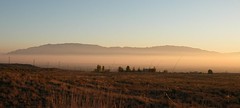What is Temperature Inversion?
What is that brown cloud in Albuquerque? Learn how a temperature inversion contributes to smog in the Rio Grande Valley.
An example of the temperature inversion that sometimes forms over Albuquerque in the winter, trapping pollution from wood stoves and other sources.
A temperature inversion traps ground level ozone and other pollutants beneath it, forming a haze of smog over the city.
Albuquerque is situated in a valley within the elevated land mass of the southwestern United States. The arid climate combined with the terrain encourages the formation of what is called a temperature inversion.
A temperature inversion means that temperature is increasing with height. In the picture to the right, there is an inversion at the interface between the lower layers.
Factors that either maintain an inversion or favor the formation of one:
- Dry air,
- Light or calm winds,
- Clear skies at night,
- Low sun angle,
- Deep, widespread snow cover,
- Atmospheric subsidence (a settling or sinking of air)
A temperature inversion at ground level traps smoke and other particulates near the surface causing hazy conditions over Albuquerque.
The trapping of pollutants causes Albuquerque’s infamous “brown cloud.” Temperature inversions form most nights in the Rio Grande Valley during the cooler months.
Photos from Albuquerque
What does a temperature inversion layer look like in Albuquerque?

